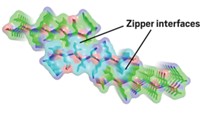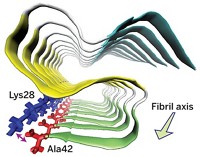Advertisement
Grab your lab coat. Let's get started
Welcome!
Welcome!
Create an account below to get 6 C&EN articles per month, receive newsletters and more - all free.
It seems this is your first time logging in online. Please enter the following information to continue.
As an ACS member you automatically get access to this site. All we need is few more details to create your reading experience.
Not you? Sign in with a different account.
Not you? Sign in with a different account.
ERROR 1
ERROR 1
ERROR 2
ERROR 2
ERROR 2
ERROR 2
ERROR 2
Password and Confirm password must match.
If you have an ACS member number, please enter it here so we can link this account to your membership. (optional)
ERROR 2
ACS values your privacy. By submitting your information, you are gaining access to C&EN and subscribing to our weekly newsletter. We use the information you provide to make your reading experience better, and we will never sell your data to third party members.
Protein Folding
Shape matters in macromolecular crowding
Compact forms are stabilized more than larger forms
by Celia Henry Arnaud
October 13, 2018
| A version of this story appeared in
Volume 96, Issue 41

In the crowded conditions typical of biological cells, nonspecific interactions can affect macromolecules’ behavior. In theoretical studies of crowding, macromolecules are often treated as sterically repulsive hard spheres, with no consideration of the actual shape of the molecules. Researchers have long hypothesized that the effects of this type of repulsion depend on a protein’s shape, but they haven’t been able to test that hypothesis. Now, Gary J. Pielak and coworkers at the University of North Carolina, Chapel Hill, have used dimers of a protein domain called GB1 to show that molecular shape does indeed matter in crowding effects (Proc. Natl. Acad. Sci. USA 2018, DOI: 10.1073/pnas.1810054115). Mutations within GB1 lead to dimers that have similar surfaces but different shapes. A single mutation in the natural protein results in a side-by-side dimer, with a shape that Pielak describes as two “kissing spheres.” Three additional mutations result in the so-called domain-swapped dimer, which is flattened and more elliptical than the other dimer. Pielak and coworkers label the proteins with 5-fluorotryptophan and use 19F NMR to determine how crowded conditions affect the dimers. As predicted, they find that the more compact domain-swapped dimer is more stabilized by crowding than is the side-by-side dimer. The results verify that shape does indeed control the effects of crowding and that more compact forms are more likely to be stabilized in the crowded cellular environment.




Join the conversation
Contact the reporter
Submit a Letter to the Editor for publication
Engage with us on Twitter